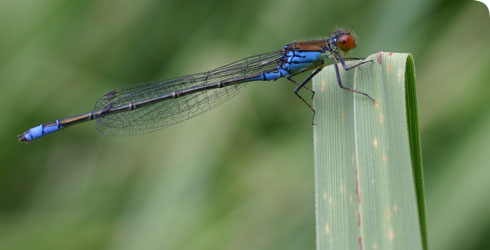Changing species distribution
The Earth’s temperature has changed many times in its history. Whenever it goes through a phase of warming, some species move towards the poles to find cooler habitats to live in while other warm weather-loving species from the south move northwards to take their place. This process is happening again now and it is evidence of global warming.
Dragonflies in the UK
Museum scientist Steve Brooks assesses the dragonfly population of the UK and the way it is affected by climate change. Dragonflies love warm temperatures and so the ones that live in the UK have mostly been confined to the south of the country, until recently.
Since 1980, 34 of 37 British species of dragonfly have expanded their range northwards by an average of 74km. This is evidence that the UK’s climate is growing warmer.
New migrants in the UK
It is not only the UK’s native dragonflies that are moving north. Visits from migrant species that live in the warmer climate of southern Europe are also increasing.
Migrant dragonfly species are those that do not live and breed in the UK but spend part of the year here. Since 1992, 5 new migrant species have been recorded.
One dragonfly species has now colonised Britain. It is called the small red-eyed damselfly, Erythromma viridulum, and it has been resident in Britain since 1999. It is now common and widespread in southern England. This is the first time a migrant species has become a new permanent resident.
Comparisons with the past
We know that global warming causes species to move northwards by looking at examples from the past.
Museum scientist Adrian Lister studies woolly mammoths and the role that climate change may have played in their extinction.
Evolution of woolly mammoths
Woolly mammoths evolved from elephants in a cold period of Earth’s history. Their woolly coats were a way of keeping warm in cold temperatures, and their teeth were adapted to eating the tough grasses that replaced forests when global temperatures fell.
For a while, the woolly mammoths were a successful species and spread over most of Europe.
Moving northwards
When the Pleistocene ice age began to draw to an end, around 15,000 years ago, woolly mammoths were no longer so well-adapted to their environment. The Earth began to warm and so forests began to grow again in place of grasslands.
To remain in their normal habitat, the mammoths had to move northwards to parts of Siberia and northern Europe, where grasslands still remained. In other parts of Europe, they died out.
Eventually, the loss of their habitat, possibly combined with human hunting, drove the mammoths to extinction.
Evidence of climate change
The northward migration of the woolly mammoths was caused by a period of global warming. The fact that species like dragonflies are again beginning to spread to the north is evidence that another period of global warming has begun.
Toolbox

In World War II the Museum was used as a secret base to develop new gadgets for allied spies, including an exploding rat!

